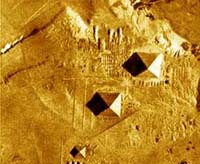![[Image - gnomon and local noon]](images/nava16b.gif) [GIF, 4k]
[GIF, 4k]
Now let us try to determine the North-South direction and to measure the exact moment of Local Noon. We will do so on a sunny day, by means of a shadow.
Here we show a shadow-keeper, a gnomon (a Greek word). It is just an ordinary pole:
In late March and late September, the end of the shadow of the gnomon will move along a straight line. But such a straight line will not appear on all days of the year. During December and June you will see a nice "hyperbolic" curve.
However, you will be able to find the exact time for Local Noon as indicated in the drawing.
Another method, described below, is a very precise invention and will give quite exact results.
Here you simply draw a circle around your gnomon. The Local Noon can then be determined from the times when the end of the shadow crosses this circle, before and after noon. This idea dates back to ancient Egypt.
In the example above, point B is passed at 11 hours 15 minutes and point A at 13 hours 15 minutes, so the Local Noon is at 12 hours 15 minutes. This type of method is also used for nautical navigation with a Sextant.
The next drawing shows yet another useful method. Look at the angle A - Gnomon - B, that is, from A to G(nomon) to B.
If you draw two circles with the same radius and with their centers in A and B, respectively, you will divide the angle AGB into two halves of the same size. Then you just draw a line from the Gnomon to the point of intersection of the two circles, as shown. This line defines the North-South direction with very good precision.
This may have been the method that enabled the ancient Egyptians to align the pyramids so accurately to the North-South-East-West directions.
 Aerial view of
two pyramids near Cairo.
Aerial view of
two pyramids near Cairo.
The pyramids were by no means placed in a random way by their builders! Modern measurements indicate a North-South orientation with very high accuracy - in many cases to within a few tenths of a degree. This is an amazingly feat, considering that many of the pyramids are nearly 5000 years old. This shows the high level of astronomy in ancient Egypt!